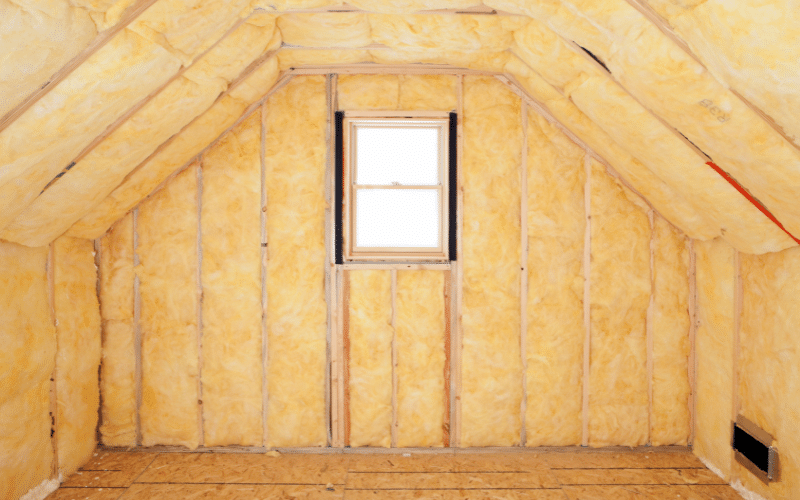Dallas: (972) 548-0088
How Long Does Attic Insulation Last?

Estimated reading time: 5 minutes
The insulation in your home’s attic is designed to regulate your home’s temperature and help reduce heating and cooling costs. So, when this material degrades, your utility bills can begin to skyrocket.
But how long does attic insulation last? The answer varies depending on the type of insulation you have, the condition of your home’s roof, and a handful of other factors.
This guide will explore the factors that impact attic insulation, helping you choose an insulation service that improves your home’s overall condition.

Table of contents
How Long Does Attic Insulation Last?
Attic insulation can last between 20 and 100 years. But many types of insulation only last a couple of decades. That’s because attic insulation is prone to several kinds of damage.
For example, moisture, pests, and extreme weather conditions are common factors that shorten insulation lifespan. It’s essential to consider these factors when determining how long attic insulation will last.
Factors That Impact Attic Insulation
The insulation in your attic may be built to last, but that doesn’t mean that it’s impervious to damage. A damaged roof that lets moisture into your attic space can contribute to insulation rot, as can pests and poor maintenance.
Overall, the most significant factors that impact attic insulation lifespan include:
- Insulation type
- Pest control services
- Roof condition
- Attic maintenance
Let’s take a moment to explore these factors in greater detail to discover how they can damage attic insulation. We’ll also discuss the steps you can take to prevent these issues.
Insulation Type
One of the most significant factors impacting attic insulation condition and lifespan is insulation type. Remember, there are several types of attic insulation, and some are more durable than others.
Common types of attic insulation include:
- Fiberglass loose-fill
- Fiberglass pads
- Cellulose loose-fill
- Spray foam
The cheapest insulation materials tend to be fiberglass. Unfortunately, they’re also some of the most challenging to work with. Airborne fiberglass particles can damage or irritate skin, eyes, and lungs.
Loose-fill fiberglass is cheap, but getting rid of it is a mess. For that reason, some homeowners opt for fiberglass pads (also called fiberglass batts). Still, these are equally dangerous to your household’s comfort and health.
Cellulose loose-fill is a little pricier, but it’s generally far safer than fiberglass. However, it’s far more prone to moisture damage and may not offer as much protection as fiberglass or foam-based insulation.
The most effective and longest-lasting type of attic insulation is spray foam insulation. This material adheres to your attic’s paneling, filling gaps and forming seals that are resistant to water and mold.
Essentially, fiberglass and cellulose insulations typically last the shortest amount of time, while spray foam insulations often enjoy the most extended lifespans.
Pest Control Services
When rodents, birds, or insects decide to make your attic their home, your insulation is bound to suffer. After all, birds may pluck bits of insulation away to build nests. Rats have even been known to eat insulation!
If you’re not investing in regular pest control services, you may notice that your attic insulation is slowly disappearing. But, of course, replacing this insulation isn’t enough to solve this problem.
There may be a small opening along your roof that’s allowing birds, rodents, and insects to enter your attic. If so, don’t be surprised to find that your insulation is covered in mold or is rotting away.
Notably, pests in your attic insulation can impact your home’s interior air quality. Homes with HVAC ducts may have ducts in their attic, which can become pathways for pests.
Rats, squirrels, raccoons, and other types of pests can burrow into your HVAC ductwork, causing insulation and debris to get sucked up into your heating and cooling system.
As such, it’s crucial to ensure that your roof is sealed, safe, and free from pests.
Roof Condition
A leaky roof can spell doom for attic insulation. When water or moisture gets trapped in your attic, it often stays there for quite some time. During warmer seasons, this humidity can rot the insulation.
If you haven’t invested in annual roof maintenance services, there’s a chance that your attic insulation is in poor shape. For that reason, it’s vital to consider your roof’s condition when determining attic insulation lifespan.
But your roof isn’t the only area you’ll want to maintain. The attic area itself requires occasional maintenance.
Attic Maintenance

Maintaining your attic isn’t the most pleasant task, nor the easiest. But, that said, a lack of attic maintenance can shorten the lifespan of your insulation. For that reason, annual maintenance services are crucial.
Typical attic maintenance tasks include checking for pests, inspecting the attic ventilation fan, and ensuring that there’s no mold or moisture damage. You may also need to put down a new layer of insulation.
Still, there are long-term solutions to attic maintenance issues. Investing in a Radiant Barrier service might be one of the best options for homeowners.
An attic Radiant Barrier service replaces your old fiberglass insulation with non-toxic materials resistant to mold and moisture and requires zero maintenance. This service can also reduce heating and cooling costs!
So, before you purchase another roll of potentially carcinogenic insulation, consider investing in a cleaner, longer-lasting alternative.
Upgrade Your Attic Insulation
How long does attic insulation last? The answer often depends on the type of insulation used, as well as the condition of the roof protecting it. For example, loose-fill fiberglass insulation can rot away in as little as 20 years.
If you’re unsure about your attic insulation age, it may be time to schedule an insulation service. After all, upgrading your attic insulation is a fantastic way to reduce heating and cooling costs and enjoy cleaner interior air.
